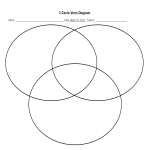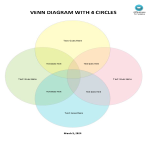Venn Diagram Example templates
How to use a Venn diagram?
A Venn diagram is a visual representation of the similarities and differences between two or more different elements. It consists of a series of shapes (usually circles) with overlapping edges. While you don't need to use a circle, it's probably the most convenient shape because multiple circles can easily overlap.
It can be used in any field of study to visually represent relationships between concepts. Each group of elements is represented as a circle or other shape, and overlapping areas are used to represent commonalities between two or more concepts.
Also use overlapping circles or other shapes to illustrate logical relationships between two or more sets of elements. You can see things in new ways and be able to make observations, decisions, arguments or decisions. They are often used to organize information graphically and to highlight similarities and differences between elements.
AllBusinessTemplates.com understands the importance of communicating by professional documents and usage of quality document templates, for example when you are an employee in a company, or a manager working on a project, being a creative artist or entrepreneur sending out professional quotes, etc. and you want to make a good impression.
Below blank Venn diagram examples are ready-made and can be downloaded and printed directly after you modified them according to your preferences.
-
Plot Venn Diagram
How to create a Plot venn diagram? Download this Plot venn diagram template now!
View template -
Funny Venn Diagram
How to create a funny venn diagram? Download this funny venn diagram template now!
View template -
Venn diagram
How to create a Venn diagram? Are you searching for a Venn diagram sample template? Download this sample Venn diagram template now which is a useful tool for visualizing relationships between two or more items
View template -
Venn diagram with 4 circles
How to create a Venn diagram with 4 circles? Are you looking for a Venn diagram template that has four circles? Download our Venn diagram template that has 4 circles and is completely easy to use.
View template
Latest topics
- GDPR Compliance Templates
What You Need To Be DPR compliant? Are you looking for useful GDPR document templates to make you compliant? All these compliance documents will be available to download instantly... - Google Sheets Templates
How to work with Google Sheets templates? Where to download useful Google Sheets templates? Check out our samples here. - Drop Shipping Agreement
How to start drop shipping? Do you need a Drop shipping Agreement? Check out our Dropshipping Agreement templates now! - Excel Templates
Where to find usefl Excel templates? How do I create a template in Excel? Check these editable and printable Excel Templates and download them directly! - Google Docs Templates
How to create documents in Google Docs? We provide Google Docs compatible template and these are the reasons why it's useful to work with Google Docs...



